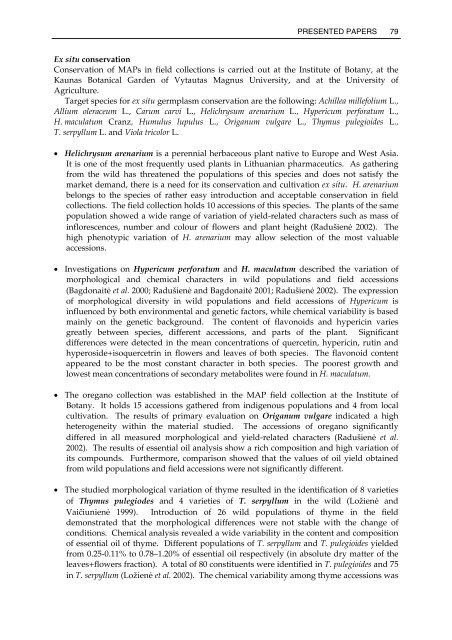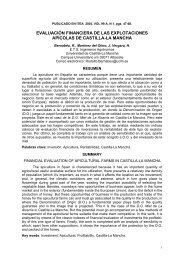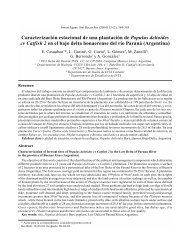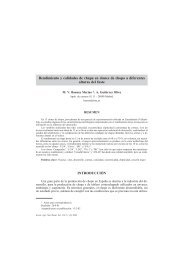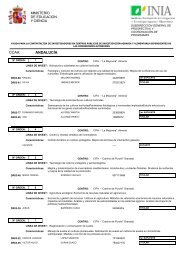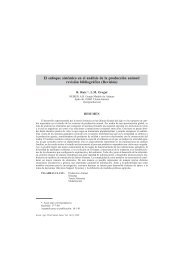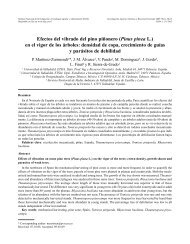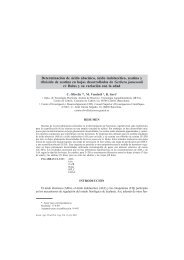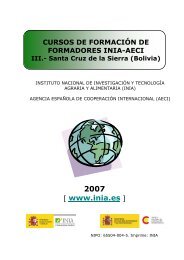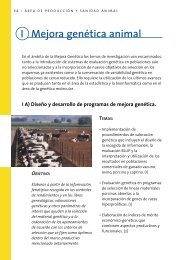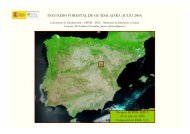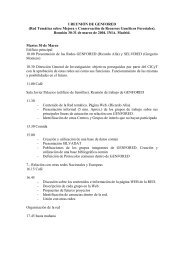Status of medicinal and aromatic plants in - Inia
Status of medicinal and aromatic plants in - Inia
Status of medicinal and aromatic plants in - Inia
You also want an ePaper? Increase the reach of your titles
YUMPU automatically turns print PDFs into web optimized ePapers that Google loves.
PRESENTED PAPERS 79<br />
Ex situ conservation<br />
Conservation <strong>of</strong> MAPs <strong>in</strong> field collections is carried out at the Institute <strong>of</strong> Botany, at the<br />
Kaunas Botanical Garden <strong>of</strong> Vytautas Magnus University, <strong>and</strong> at the University <strong>of</strong><br />
Agriculture.<br />
Target species for ex situ germplasm conservation are the follow<strong>in</strong>g: Achillea millefolium L.,<br />
Allium oleraceum L., Carum carvi L., Helichrysum arenarium L., Hypericum perforatum L.,<br />
H. maculatum Cranz, Humulus lupulus L., Origanum vulgare L., Thymus pulegioides L.,<br />
T. serpyllum L. <strong>and</strong> Viola tricolor L.<br />
• Helichrysum arenarium is a perennial herbaceous plant native to Europe <strong>and</strong> West Asia.<br />
It is one <strong>of</strong> the most frequently used <strong>plants</strong> <strong>in</strong> Lithuanian pharmaceutics. As gather<strong>in</strong>g<br />
from the wild has threatened the populations <strong>of</strong> this species <strong>and</strong> does not satisfy the<br />
market dem<strong>and</strong>, there is a need for its conservation <strong>and</strong> cultivation ex situ. H. arenarium<br />
belongs to the species <strong>of</strong> rather easy <strong>in</strong>troduction <strong>and</strong> acceptable conservation <strong>in</strong> field<br />
collections. The field collection holds 10 accessions <strong>of</strong> this species. The <strong>plants</strong> <strong>of</strong> the same<br />
population showed a wide range <strong>of</strong> variation <strong>of</strong> yield-related characters such as mass <strong>of</strong><br />
<strong>in</strong>florescences, number <strong>and</strong> colour <strong>of</strong> flowers <strong>and</strong> plant height (Radušienė 2002). The<br />
high phenotypic variation <strong>of</strong> H. arenarium may allow selection <strong>of</strong> the most valuable<br />
accessions.<br />
• Investigations on Hypericum perforatum <strong>and</strong> H. maculatum described the variation <strong>of</strong><br />
morphological <strong>and</strong> chemical characters <strong>in</strong> wild populations <strong>and</strong> field accessions<br />
(Bagdonaitė et al. 2000; Radušienė <strong>and</strong> Bagdonaitė 2001; Radušienė 2002). The expression<br />
<strong>of</strong> morphological diversity <strong>in</strong> wild populations <strong>and</strong> field accessions <strong>of</strong> Hypericum is<br />
<strong>in</strong>fluenced by both environmental <strong>and</strong> genetic factors, while chemical variability is based<br />
ma<strong>in</strong>ly on the genetic background. The content <strong>of</strong> flavonoids <strong>and</strong> hyperic<strong>in</strong> varies<br />
greatly between species, different accessions, <strong>and</strong> parts <strong>of</strong> the plant. Significant<br />
differences were detected <strong>in</strong> the mean concentrations <strong>of</strong> quercet<strong>in</strong>, hyperic<strong>in</strong>, rut<strong>in</strong> <strong>and</strong><br />
hyperoside+isoquercetr<strong>in</strong> <strong>in</strong> flowers <strong>and</strong> leaves <strong>of</strong> both species. The flavonoid content<br />
appeared to be the most constant character <strong>in</strong> both species. The poorest growth <strong>and</strong><br />
lowest mean concentrations <strong>of</strong> secondary metabolites were found <strong>in</strong> H. maculatum.<br />
• The oregano collection was established <strong>in</strong> the MAP field collection at the Institute <strong>of</strong><br />
Botany. It holds 15 accessions gathered from <strong>in</strong>digenous populations <strong>and</strong> 4 from local<br />
cultivation. The results <strong>of</strong> primary evaluation on Origanum vulgare <strong>in</strong>dicated a high<br />
heterogeneity with<strong>in</strong> the material studied. The accessions <strong>of</strong> oregano significantly<br />
differed <strong>in</strong> all measured morphological <strong>and</strong> yield-related characters (Radušienė et al.<br />
2002). The results <strong>of</strong> essential oil analysis show a rich composition <strong>and</strong> high variation <strong>of</strong><br />
its compounds. Furthermore, comparison showed that the values <strong>of</strong> oil yield obta<strong>in</strong>ed<br />
from wild populations <strong>and</strong> field accessions were not significantly different.<br />
• The studied morphological variation <strong>of</strong> thyme resulted <strong>in</strong> the identification <strong>of</strong> 8 varieties<br />
<strong>of</strong> Thymus pulegiodes <strong>and</strong> 4 varieties <strong>of</strong> T. serpyllum <strong>in</strong> the wild (Ložienė <strong>and</strong><br />
Vaičiunienė 1999). Introduction <strong>of</strong> 26 wild populations <strong>of</strong> thyme <strong>in</strong> the field<br />
demonstrated that the morphological differences were not stable with the change <strong>of</strong><br />
conditions. Chemical analysis revealed a wide variability <strong>in</strong> the content <strong>and</strong> composition<br />
<strong>of</strong> essential oil <strong>of</strong> thyme. Different populations <strong>of</strong> T. serpyllum <strong>and</strong> T. pulegioides yielded<br />
from 0.25-0.11% to 0.78–1.20% <strong>of</strong> essential oil respectively (<strong>in</strong> absolute dry matter <strong>of</strong> the<br />
leaves+flowers fraction). A total <strong>of</strong> 80 constituents were identified <strong>in</strong> T. pulegioides <strong>and</strong> 75<br />
<strong>in</strong> T. serpyllum (Ložienė et al. 2002). The chemical variability among thyme accessions was


